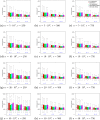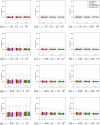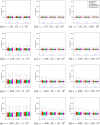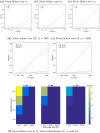One-step estimation of networked population size: Respondent-driven capture-recapture with anonymity
- PMID: 29698493
- PMCID: PMC5919671
- DOI: 10.1371/journal.pone.0195959
One-step estimation of networked population size: Respondent-driven capture-recapture with anonymity
Abstract
Size estimation is particularly important for populations whose members experience disproportionate health issues or pose elevated health risks to the ambient social structures in which they are embedded. Efforts to derive size estimates are often frustrated when the population is hidden or hard-to-reach in ways that preclude conventional survey strategies, as is the case when social stigma is associated with group membership or when group members are involved in illegal activities. This paper extends prior research on the problem of network population size estimation, building on established survey/sampling methodologies commonly used with hard-to-reach groups. Three novel one-step, network-based population size estimators are presented, for use in the context of uniform random sampling, respondent-driven sampling, and when networks exhibit significant clustering effects. We give provably sufficient conditions for the consistency of these estimators in large configuration networks. Simulation experiments across a wide range of synthetic network topologies validate the performance of the estimators, which also perform well on a real-world location-based social networking data set with significant clustering. Finally, the proposed schemes are extended to allow them to be used in settings where participant anonymity is required. Systematic experiments show favorable tradeoffs between anonymity guarantees and estimator performance. Taken together, we demonstrate that reasonable population size estimates are derived from anonymous respondent driven samples of 250-750 individuals, within ambient populations of 5,000-40,000. The method thus represents a novel and cost-effective means for health planners and those agencies concerned with health and disease surveillance to estimate the size of hidden populations. We discuss limitations and future work in the concluding section.
Conflict of interest statement
Figures








Similar articles
-
Hidden population size estimation from respondent-driven sampling: a network approach.J Am Stat Assoc. 2018;113(522):755-766. doi: 10.1080/01621459.2017.1285775. Epub 2018 Mar 6. J Am Stat Assoc. 2018. PMID: 30828120 Free PMC article.
-
NEW SURVEY QUESTIONS AND ESTIMATORS FOR NETWORK CLUSTERING WITH RESPONDENT-DRIVEN SAMPLING DATA.Sociol Methodol. 2017 Aug;47(1):274-306. doi: 10.1177/0081175017716489. Epub 2017 Jul 6. Sociol Methodol. 2017. PMID: 30337767 Free PMC article.
-
Hidden population size estimation and diagnostics using two respondent-driven samples with applications in Armenia.Biom J. 2023 Jun;65(5):e2200136. doi: 10.1002/bimj.202200136. Epub 2023 Mar 6. Biom J. 2023. PMID: 36879484
-
Variance estimation, design effects, and sample size calculations for respondent-driven sampling.J Urban Health. 2006 Nov;83(6 Suppl):i98-112. doi: 10.1007/s11524-006-9106-x. J Urban Health. 2006. PMID: 16937083 Free PMC article. Review.
-
The development of respondent-driven sampling (RDS) inference: A systematic review of the population mean and variance estimates.Drug Alcohol Depend. 2020 Jan 1;206:107702. doi: 10.1016/j.drugalcdep.2019.107702. Epub 2019 Nov 1. Drug Alcohol Depend. 2020. PMID: 31761476
Cited by
-
Estimating Hidden Population Sizes with Venue-based Sampling: Extensions of the Generalized Network Scale-up Estimator.Epidemiology. 2019 Nov;30(6):901-910. doi: 10.1097/EDE.0000000000001059. Epidemiology. 2019. PMID: 31299014 Free PMC article.
-
Estimating the size of hard to sample populations: A comprehensive study on female sex workers and sexually exploited minors in Rwanda using privatized network sampling in 2023.PLoS One. 2025 Aug 21;20(8):e0329772. doi: 10.1371/journal.pone.0329772. eCollection 2025. PLoS One. 2025. PMID: 40839657 Free PMC article.
References
Publication types
MeSH terms
Grants and funding
LinkOut - more resources
Full Text Sources
Other Literature Sources

